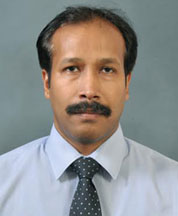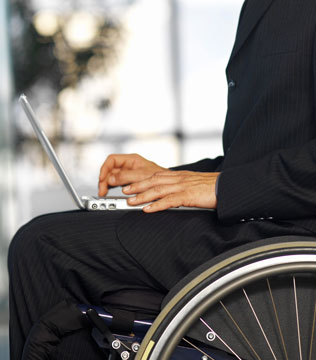|
Disabled doesn’t translate to unable:
Think differently abled
by Carol Aloysius
The surge in road and home accidents along with falls, arthritic
ailments, vision and hearing loss, and brain damage, which have also
spiked due to Sri Lanka’s rapidly aging population, has all meant that
the number of persons with disabilities in Sri Lanka has soared
phenomenally in recent years. Though many continue to contribute in a
meaningful manner to society despite their disabilities, the stigma of
being disabled, dogs their every move as much as the physical barriers
that prevent them from participating in activities normal persons do.
|

Dr Gopi Kitnasamy |
On International Day of Disabled Persons (IDDP) which fell on
December 3, several organisations worldwide came together to dislodge
those barriers by promoting better understanding of disability issues,
including their right to be treated as equals and the importance of
integrating the disabled into all aspects of society - cultural,
economic and social - by giving them the opportunity and choice to do
so.
While the focus has been mainly on adult disability, at least one
non-governmental organisation, the Cerebral Palsy Lanka Foundation (CPLF)
Sri Lanka, has tried to improve the lives of children who are prevented
from participating in outdoor activities because of a lack of proper
facilities. To this end, CPLF has devised wheel chair swings in the
kiddies section of at least three public parks in the city. Here,
Chartered Physiotherapist and Chairman of the CPLF, Dr Gopi Kitnasamy,
who is also a father of a child with CP, and has been spearheading
innovative ways of helping his patients young and old who suffer from
various forms of disabilities discusses some of the most pressing issues
related to disability and how they can be overcome.
Excerpts…
Q: Disability is a complex term. How do you interpret it?
A: Many people think the term ‘Disability’, only refers to
people using a wheelchair or walker or has some physical disability that
makes him/her seem weaker or less important in the eyes of those without
such disabilities. But this is a misconception.
The term is used to refer to individual functioning, including
physical impairment, sensory impairment, cognitive impairment,
intellectual impairment mental illness, and various types of chronic
disease. A person is considered to have a disability if he or she has
difficulty performing certain functions (seeing, hearing, talking,
walking, climbing stairs and lifting and carrying), or has difficulty
performing activities of daily living, or has difficulty with certain
social roles (doing school work for children, working at a job and
around the house for adults.
Q: You referred to physical, mental and intellectual
disabilities. Are they the different categories under which disabilities
fall?
A: ‘Disability’ can be broken down into a number of broad
sub-categories, such as:
Mobility and Physical Impairments:
This category of disability includes people with varying types of
physical disabilities including:
Upper limb(s) disability
Lower limb(s) disability
Manual dexterity
Disability in co-ordination with different organs of the body
Disability in mobility can be either an in-born or acquired with age
problem. It could also be the effect of a disease. People who have a
broken bone also fall into this category of disability.
b) Spinal Cord Disability:
Spinal cord injury (SCI) can sometimes lead to lifelong disabilities.
This kind of injury mostly occurs due to severe accidents. The injury
can be either complete or incomplete. In an incomplete injury, the
messages conveyed by the spinal cord are not completely lost.
Whereas a complete injury results in a total dys-functioning of the
sensory organs. In some cases spinal cord disability can be a birth
defect.
c) Head Injuries - Brain Disability:
A disability in the brain occurs due to a brain injury. The magnitude
of the brain injury can range from mild, moderate and severe. There are
two types of brain injuries:
Acquired Brain Injury (ABI)
Traumatic Brain Injury (TBI)
ABI is not a hereditary type defect but is the degeneration that
occurs after birth. TBI results in emotional dysfunctioning and
behavioral disturbance.
d) Vision Disability:
Thousands of people suffer from minor to various serious vision
disability or impairments. Eye injuries can also result in blindness and
ocular trauma, while chronic diseases like diabetes can also result in
vision loss.
e) Hearing Disability:
Hearing disabilities includes people that are completely or partially
deaf. Deafness can be evident at birth or occur later in life from
several biologic causes, for example meningitis can damage the auditory
nerve or the cochlea.
|

Pic - plboard.com |
f) Cognitive or Learning Disabilities:
Cognitive Disabilities are kind of impairment present in people who
are suffering from dyslexia and various other learning difficulties and
includes speech disorders.
f) Psychological Disorders. These include the following:
Affective Disorders: Disorders of mood or feeling states either short
or long term.
Mental Health Impairment is the term used to describe people who have
experienced psychiatric problems or illness such as:
Personality Disorders - Defined as deeply inadequate patterns of
behavior and thought of sufficient severity to cause significant
impairment to day-to-day activities.
Schizophrenia: A mental disorder characterized by disturbances of
thinking, mood, and behavior.
Q: Do all disabilities show visible outer symptoms?
A: There is in addition a group we refer to as Invisible
Disabilities. Invisible Disabilities are disabilities that are not
immediately apparent to others. The term invisible
disabilities refers to symptoms such as debilitating pain, fatigue,
dizziness, cognitive dysfunctions, brain injuries, learning differences
and mental health disorders, as well as hearing and vision impairments.
These are not always obvious to the onlooker, but can sometimes or
always limit daily activities and vary from person to person. For
example, some people with visual or auditory disabilities, who do not
wear glasses or hearing aids, or discreet hearing aids, may not be
obviously disabled. Some people who have vision loss may wear contacts.
A sitting disability is another category of invisible impairments;
sitting problems are usually caused by chronic back pain. Those with
joint problems or chronic pain may not use mobility aids on some days,
or at all. Most people with (Repetitive Strain Injuries) RSI move in a
‘normal’ and inconspicuous way, and are even encouraged by the medical
community to be as active as possible, including playing sports. Yet
those patients can have dramatic limitations in how much they can type,
write or how long they can hold a phone or other objects in their hands.
In addition there are ‘Hidden Disabilities’.
Q: Examples of ‘Hidden disabilities’?
A: Psychiatric Disabilities such as major depression, bipolar
disorder, schizophrenia and anxiety disorders, post-traumatic stress
disorder. Traumatic Brain Injury, Epilepsy, HIV/AIDS, Diabetes, Chronic
Fatigue Syndrome, Cystic Fibrosis, Attention Deficit-Disorder or
Attention-Deficit/Hyperactivity Disorder (ADD/ADHD) Learning
Disabilities (LD)
Q: How are they treated?
A: Depending on their medical conditions, most of them need to
be controlled and treated with medications and other therapeutic
interventions.
Q: Historically, disabilities have often been cast in a
negative light. Your comments?
A: Over the past 20 years, a competing view known as the
social model of disability has come to the fore. In this model,
disability is seen more as a social construction than a medical reality.
An individual may be impaired by a condition that requires daily living
adaptations, but the bulk of his problem - his disability - can be found
in the attitudinal and physical barriers erected by society.
Q: Do both models agree at some point?
A: Both the medical and social models agree, to a point, that
facilities and opportunities should be made as accessible as possible to
individuals who require adaptations. Dismantling physical barriers, or
setting up adaptations such as wheelchair ramps, are known as “fostering
accessibility”.
Q: How relevant is this year’s theme for International Day of
Persons with Disability to the current needs of all persons living with
disabilities?
A: This year’s theme ‘Inclusion matters: access and
empowerment of people of all abilities’ is very significant considering
that more such persons are taking an active role in almost every aspect
of society. Yet barriers they face to inclusion in these key aspects of
society , has resulted in one billion persons worldwide and in Sri Lanka
not being able to enjoy access to society on an equal basis with others,
such as transportation, employment, education as well as social and
political participation. The key solution is empowering them, investing
in people irrespective of whether they are disabled or not in jobs,
health, nutrition, education, and social protection.
Q: It is estimated that by 2050, 66% of the world’s population
will be living in cities. The idea of setting up Megacities in South
Asia is under consideration. In this light how can we ensure that those
with disabilities are not left out when these future cities are built?
A: By ensuring their basic urban infrastructures and services
are more environmentally accessible, user-friendly and inclusive of all
people’s needs, including persons with disabilities Design of products,
devices, services, or environments must also include the needs of people
with disabilities. In other words, create products usable in the widest
range of situations, by everyone - whether they have a disability or
not.
Q: Currently there is a lack of disability data and statistics
worldwide and in Sri Lanka. How has this lack impacted on people with
disabilities? Is there a move to bridge this gap?
A: The lack of data and information on disability and the
situation of persons with disabilities at the national level contribute
to the invisibility of persons with disabilities in official statistics.
This presents a major obstacle to achieving development planning and
implementation that is inclusive of persons with disabilities. The
International Day will be used to highlight measures to strengthen
national capacities to improve and mainstream disability data
collection, based on existing good practices.
Q.Your message?
A. People often judge others by what
they see and often conclude a person can or cannot do something by the
way they look. The bottom line is that everyone is different, with
varying challenges and needs, as well as abilities and attributes. Thus,
we all should learn to listen with our ears, instead of judging with our
eyes. |

